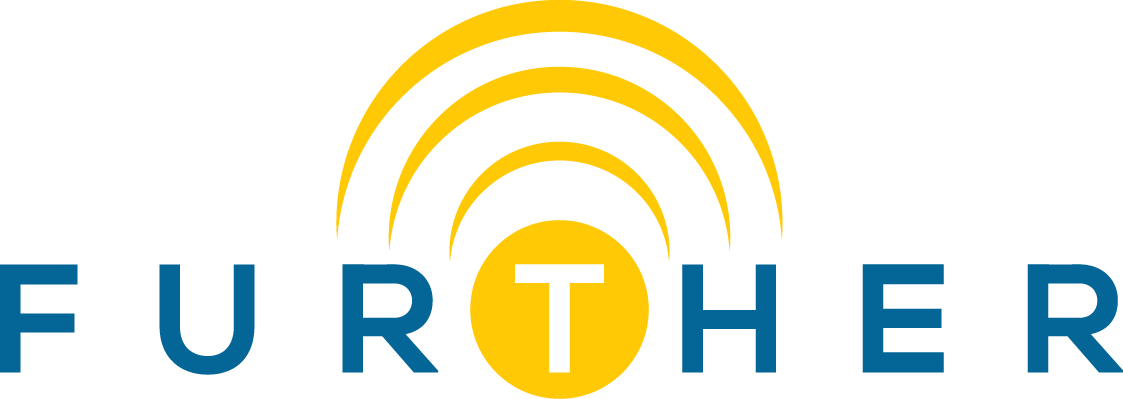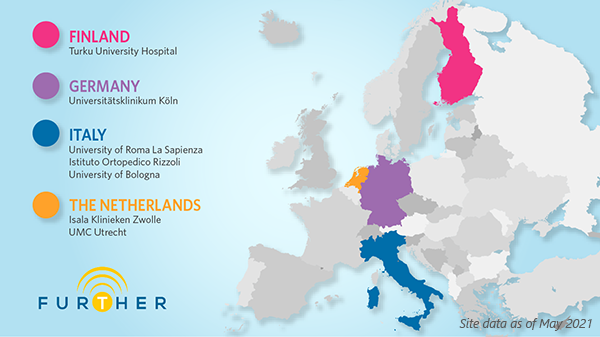Key Points
- A multicenter, randomized controlled trial for alleviating the pain from bone metastases in cancer patients is underway in four European countries.
- In all, 216 patients will receive one of three proven treatments, including focused ultrasound.
- All treatment centers and the Foundation partner in the FURTHER consortium, which recently held its 2nd annual symposium.
 A prospective, multicenter, three-armed randomized controlled trial for alleviating the pain from bone metastases in cancer patients is now underway at seven hospitals in four European countries (Netherlands, Finland, Germany, Italy). University Medical Center (UMC) Utrecht, a Focused Ultrasound Center of Excellence, is the coordinating center for the trial, which is called Focused Ultrasound and RadioTHERapy for Noninvasive Palliative Pain Treatment in Patients with Bone Metastases (FURTHER), NCT04307914. The Principal Investigator is Dr. Helena M. Verkooijen, MD, PhD, a full professor at UMC Utrecht.
A prospective, multicenter, three-armed randomized controlled trial for alleviating the pain from bone metastases in cancer patients is now underway at seven hospitals in four European countries (Netherlands, Finland, Germany, Italy). University Medical Center (UMC) Utrecht, a Focused Ultrasound Center of Excellence, is the coordinating center for the trial, which is called Focused Ultrasound and RadioTHERapy for Noninvasive Palliative Pain Treatment in Patients with Bone Metastases (FURTHER), NCT04307914. The Principal Investigator is Dr. Helena M. Verkooijen, MD, PhD, a full professor at UMC Utrecht.
In the trial, a total of 216 patients with painful bone metastases will be randomized in a 1:1:1 ratio to receive external beam radiotherapy (EBRT) only, MR-guided high intensity focused ultrasound (MR-HIFU) only, or EBRT followed by MR-HIFU.
 The trial has been funded by the European Commission’s Horizon 2020 program, and the collaborating centers are (*=currently enrolling):
The trial has been funded by the European Commission’s Horizon 2020 program, and the collaborating centers are (*=currently enrolling):
- Isala Klinieken Zwolle (The Netherlands)*
- UMC Utrecht (The Netherlands)*
- Turku University Hospital (Finland)
- Universitätsklinikum Köln (Germany)
- University of Roma La Sapienza (Italy)*
- Istituto Ortopedico Rizzoli (Italy)
- University of Bologna (Italy)
Each of the six treatment centers is a partner in the FURTHER consortium, which recently held its 2nd annual symposium. The Focused Ultrasound Foundation is also a partner in the FURTHER consortium.
Cancer-induced bone pain from bone metastases strongly interferes with quality of life and daily functioning of patients with advanced cancer. The current standard of care for patients with painful bone metastasis includes palliative EBRT, which is a well-established treatment option, but it takes up to six weeks for EBRT to induce optimal pain relief, and 30-40% of patients do not respond to EBRT. Pain palliation may be improved by including MR-HIFU as alternative or in addition to EBRT. Adults with cancer metastases who were referred to the department of radiation oncology for treatment of painful bone metastases (with a pain score of 4 out of 10 or greater on the numerical rating scale) are eligible to enroll in the trial.
“The sites that are not yet enrolling had institutional review board (IRB) delays because of the COVID-19 pandemic,” said Thomas Andreae, PhD, the Foundation’s Focused Ultrasound Ambassador in Europe. “But now, they are all IRB cleared and finalizing plans to begin recruiting.”
Largely due to the COVID-19 challenges, to date, less than ten patients have been treated. However, the three-arm protocol will present a challenge for finding patients that are suitable for randomization to all three arms.
“The investigators are reporting that some patients do not want to be randomized because they have decided that they have a strong preference for MR-HIFU or standard radiotherapy,” said Prof. Verkooijen. “Also, some other patients may not be eligible for the FURTHER trial. Therefore, we are establishing a registry to record patients who have been treated with MR-HIFU outside the FURTHER trial, in order not to lose valuable information on these patients. This registry will include treatment data and follow-up from patients treated with MR-HIFU.”
The primary outcome measure of the FURTHER trial is pain response at 14 days after completion of the treatment. Secondary outcomes include pain response at 14 days after inclusion, pain scores, toxicity, adverse events, quality of life, and survival in the first 6 months after treatment.
Beyond comparing the effectiveness of the treatments, the investigators will also evaluate the cost effectiveness of each treatment arm. A health economics group at Universitätsklinikum Köln has developed a detailed process chart to track the patient journey and log the time spent for each treatment. This team has calculated fixed costs for each treatment. The cost analysis template may be helpful for determining procedure costs in other countries and serve as a guide for other diseases; however, many health care systems and payment structures around the world are different from the typical European situation.
The FURTHER consortium investigators are open to sharing the study protocol with other interested sites willing to follow the same protocol. Additional locations will be welcomed to join the trial at a later date.
Highlights from the 2nd Annual FURTHER Consortium meeting include:
- The consortium is ready and eager to start patient inclusions.
- The trial database has been set up.
- Screening of patients has commenced in the Netherlands.
- Bologna has had its initiation visit, and Rome’s initiation is planned.
- Turku has received IRB approval.
- The COVID-19 pandemic has slowed enrollment, with physicians on other tasks and hospitals locked down for Medical studies that require additional patient visits/personnel.
- Cyril Ferrer, PhD, presented a delineation study and asked all partners to delineate the targeted metastasis and the targeted ablation volume, according to their current practices in the treatment of bone metastases. These data will be used as a basis for converging on the treatment strategy of bone metastases.
- Julia Simoes Correa Galendi presented an analysis on the cost structure and first cost data for the MR-HIFU treatment arm.
- Jorik Slotman, MD, presented an analysis of the MR-HIFU patient screening process at Isala.
